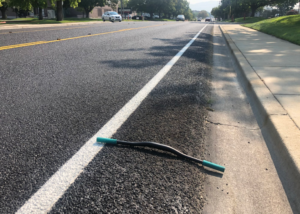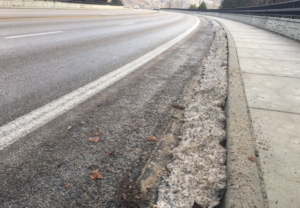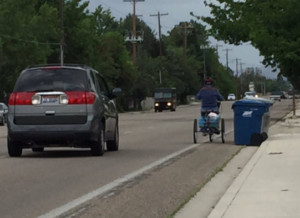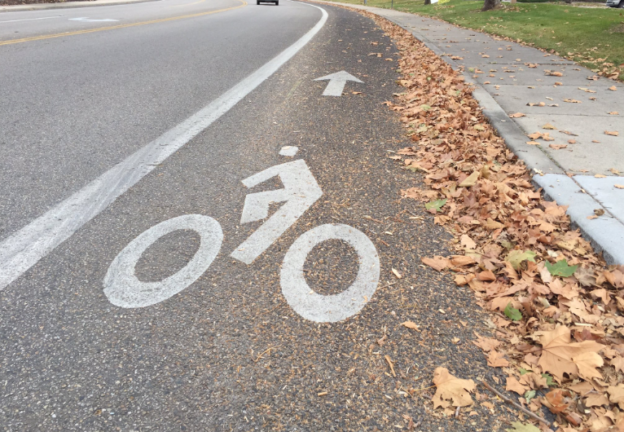By Don Kostelec
October 30, 2018
Many bicycling advocates are told by traffic engineers that the gutter or gutter pan along a street

A bike lane in Nashville is designed to expect the bicyclist to ride on the joint between the asphalt lane and gutter pan.
is counted as the bike lane when they measure its width. Simply put: It does not. And this shouldn’t be a difficult issue for engineers to understand.
Unfortunately, too many miles of bike lanes across the United States are measured as if the gutter does count as bike lane width. I know that locally where I am in Boise, that the highway district that manages all the local streets counts the gutter pan as bike lane width then reports these substandard bike lanes in their tally of bike lane miles for their Bicycle Friendly Community application.
In writing this post I wanted to provide advocates, planners, engineers, and bicyclists everywhere with as comprehensive of a debunking of the “gutter pan counts” myth. If you follow me on Twitter, you’ve seen my posts with the hashtag #GutterDoesntCount.
The gutter is there for stormwater conveyance, not bicyclist use. This video I shot on Bown Way in Boise illustrates how a gutter is meant to function in channelizing stormwater away from the street.
Video: The gutter doing what it is supposed to do.
This primary issue seems to be that agencies that insist on counting the gutter pan as bike lane width don’t have a firm grasp of the conditions on their own streets that negate their ability to count the gutter. They also seem to lack a working understanding of what is published by organizations like the Federal Highway Administration and AASHTO (the national association and lobbying organization of state DOTs that also develops a majority of the accepted design guidance for roads).
Let’s start there.
What the Guidebooks Say
The Federal Highway Administration’s Office of Safety organizes and conducts trainings to designers on bicyclist facility design. Lesson 19 in the FHWA Course on Bicycle and Pedestrian Transportation (https://safety.fhwa.dot.gov/PED_BIKE/univcourse/pdf/swless19.pdf) states:
- “On streets where the bike lane is adjacent to the curb and the curb includes a 1-foot to 2-foot gutter pan, bike lanes should be a minimum 4-feet wide (width does not include the gutter pan, since bicyclists are typically unable to use this space).” Page 2.
This statement aligns with what AASHTO’s Green Book’s overall statement on the utility of the gutter pan when it comes to use as a travel way. Section 4.7.2 of the Green Book says:
- “A gutter of contrasting color or texture (black asphalt vs gray concrete) should not be considered part of the traveled way.”

The concrete gutter is oftentimes at a different slope than the asphalt lane and its surface is rarely flush with the lane.
Let’s explore that further. The common design treatment for a road is a concrete gutter that is built to match an asphalt lane. Concrete lasts longer than asphalt and when leaves and other debris clog stormwater systems the concrete keeps standing water or water going through a freeze/thaw cycle from damaging the pavement compared to if that same water remained on top of asphalt.
There are some instances, most frequently seen on concrete bridge decks, where the full surface is one material from curb to curb and, in those cases the gutter area may be tallied in the calculation of width. Rarely will you see asphalt paved all the way to the face of the concrete curb, but it does happen on older streets. For bicyclists I would strongly suggest not including that space in the lane calculation given the outside foot or so is likely to have flowing water during or after a rain event.
The Green Book goes on to state that “any form of curb has some effect on the lateral position of drivers; drivers tend to move away from a curb, which reduces effective through-lane width.” Streets with more crowning (steeper slopes from the center of the road to the curbing) have changes in slope at the gutter/asphalt joint. AASHTO goes on to state “A gutter with an evident longitudinal joint and somewhat steeper cross slope than the adjacent lane is a greater deterrent to driving near the gutter than the situation in the which traveled way and gutter are integral.”
Does it stand to reason that if the gutter and curb have this effect on drivers that it would have at least the same, if not greater, influence on bicyclists? The fact that the gutter is of a different material and grade has a direct influence on its use by bicyclists, especially in how tires respond to surface conditions when wet.
How Street Design & Street Management Practices Influences the Gutter
In a perfect world, the joint between an asphalt bike and a concrete gutter would remain flush for the life cycle of the street. Please let me know when you find that perfect world.

If you’re lucky enough to have snow plowed from bike lanes, you’ll likely find it placed in the gutter.
One of my frustrations with agency representatives who still believe the gutter counts as usable bike lane width is that they don’t understand their own agency’s practices.
While a brand new road may have a flush transition from the gutter to the asphalt travel lane, that condition does not remain for very long. Brand new roads tend to settle and create small vertical offsets at that joint. That joint may also widen over time to create a gap between the asphalt and gutter.
Street maintenance practices like chipseals and overlays create lips at the gutter. Rarely are contractors inspected so closely to ensure a flush joint is preserved when a fresh layer is applied on an overlay project where the top layer is rotomilled off so the new layer can be placed on top of it. Chipseals add height to the asphalt roadway and oftentimes lack smooth lines at the gutter due to difficulties in applying straight lines on the edges when roads are chipsealed.
Video: The impact of chipseals on the gutter/asphalt joint
Regarding street design, a lack of buffered sidewalks is a key influence on why the gutter pan

A lack of buffered sidewalks means trash bins are placed in the gutter, negating its use as a bike lane.
never counts in those situations. If sidewalks abut the curb, things like trash bins and leaf bags are placed in the gutter and intrude on the bike lane. If an agency counts the gutter as bike lane width, does this mean its substandard on trash days or when leaves are put to curb for weeks on end in the fall?
Snow management practices also negate any claim of the gutter being of a usable width. Again, a lack of buffered sidewalks means the snow is plowed to the gutter (if you’re lucky enough to have them plow the bike lane).
Construction signs that can’t obstruct the bike lane or sidewalk are oftentimes placed so they straddle the curb and gutter area.
Video: The gutter doing its job.

